|
Because of the increasing numbers of foreign volunteers coming
from all over Europe, the Germans authorized and issued national
insignia to be worn on Werhmacht uniforms. | |
|
In 1941, many of the volunteers from Denmark, Flanders, Holland and Norway
formed their own foreign legions under the auspices of the Waffen-SS.
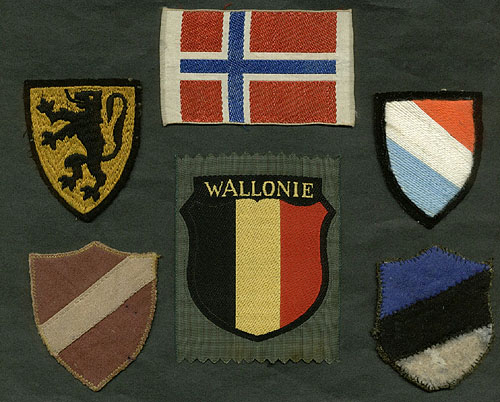
The Flemish Legion shown on your left was the official German issued arm shield (50mm x 60mm). The shield shows an embroidered black lion and yellow shield on a black wool base background. The small Norwegian flag patch was locally produced and issued to the Norwegian Volunteer Legion. The Flag is machine woven on a white cotton material and measures 48mm x 65mm. The 1st pattern Dutch shield was locally produced and issued to the Dutch Volunteer Legion. The Dutch shield is embroidered on a black wool base material and measures 50mm x 38mm. The 1st pattern Latvian shield was locally produced and issued to the Latvian Volunteer Legion. The shield (50mm x 64mm) is made of red cloth with a white diagonal cotton cloth sewn on a thin white canvas material. The 1st pattern Walloon shield, German made was issued to the Walloon Volunteer Legion. This army pattern shield remained with the legion even when it was transferred to the Waffen-SS. The shield measures 70mm x 66mm and is machine woven with the national colors, which is commonly referred as BeVo style. The Estonian shield was locally produced and issued to Estonian Border Guard and Police troops. This shield (48mm x 62mm) is made of wool base cloth material sewn on a white thin canvas material. |
|
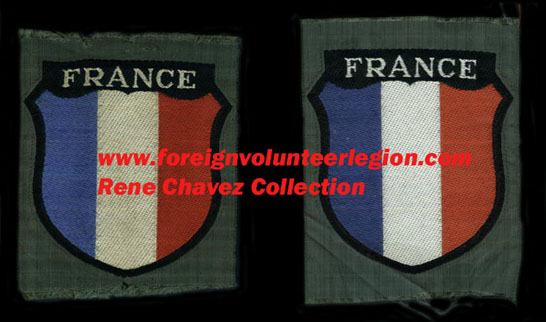
French Volunteer Legion BeVo Shields The 1st pattern French Volunteer Legion shield, German made was issued to the French Volunteer Legion. This army pattern shield remained with the legion even when it was transferred to the Waffen-SS. The shield measures 70mm x 66mm and is machine woven with the national colors, which is commonly referred as BeVo style. | |
|
A very rare early pattern locally produced Latvian shield. It shows the Latvian National colors with a separate black field sewn at the top, and with the inscription "LATVIJA" in white. 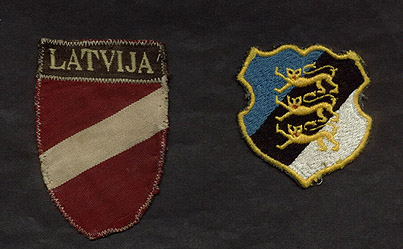
Baltic Legion Shields.
Next is another rare German made RZM pattern Estonian shield.
This embroidered heraldic style shield shows three golden lions
with black eyes and red tongues. The background shows the Estonian
National colors. This shield was intended only for Police and
Border Guard units. This shield was worn by many volunteers in
the
"SS-Freiwilligen Bataillon Narwa," which was assigned to the
German SS Panzer-Greandier Division Wiking. It was also intended
for used by members of the Reserve Regiment of the 20th SS Division. |
|
|
Finnish Volunteer Shields The first mentioned discussing the Finnish volunteer insignia was found in a Government Document dated in early August 1941. The first shields were made in Finland. On top center is a locally made shield (44mm x 50mm) with the correct heraldic colors. The yellow lion and white roses are embroidered on red silken cloth background. The blades of both the lions sword and the scimitar below are white color as well as the lions right arm. The outer edge is yellow and on the reverse it shows a fine white paper backing to strengthen the insignia. 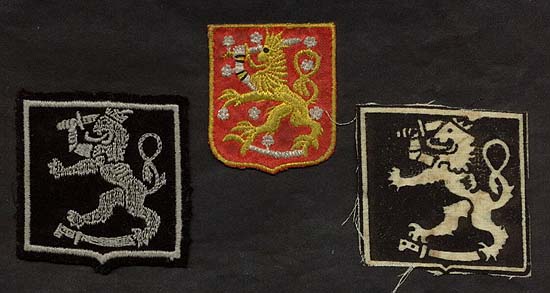
SS Finnish Arm Shields
There is also another much rare locally made shield that is exactly
the same but in a light gray thread on a black background. These
shields were granted official German authorization and were delivered
to Berlin military training barracks in autumn of 1941. There is
picture evidence showing these shields were worn in early 1942.
Below left is a very rare German made RZM approved shield (58mm
x 58mm). The heraldic symbol is embroidered with a light gray thread
on a black wool background. The reverse shows a very fine net cloth.
There is a possibility that this shield was probably issued in May
1943 as seen in photographic evidence, just two months later the
Finnish Battalion was disbandment. |
|
|
Waffen SS Arm Shields 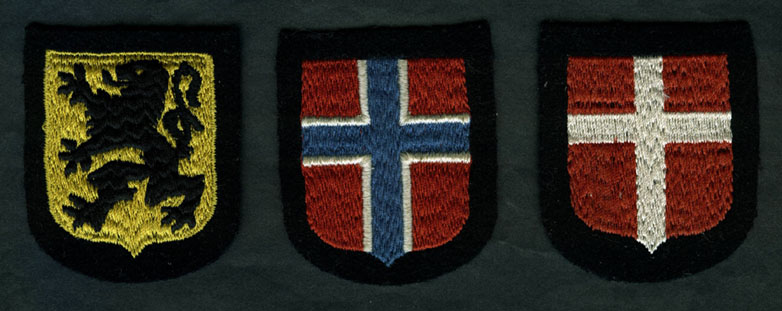
Waffen-SS Arm Shields
The Flemish shield was probably issued and worn during the re-formation
of the
"6.SS-Freiwilligen-Sturmbrigade Langemarck" around May
1944. 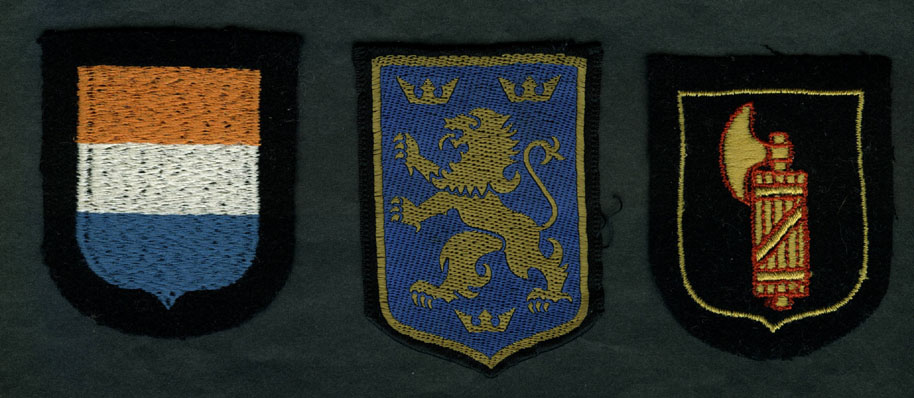
The Dutch National Shield was issued and worn by volunteers in
the
"SS-Freiwilligen Panzer-Grenadier Brigade Nederland." 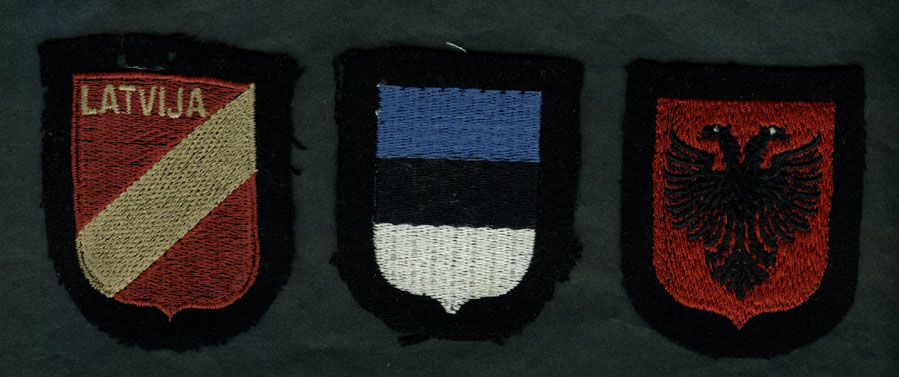
The Latvian SS late pattern shield was issued and worn by volunteers
in
"15. Waffen-Grenadier Division der SS Lettische." It is likely
that this shield was also worn by Latvians in the "2. Waffen-Grenadier
SS Lettische Brigade" and "19. Waffen-Grenadier Division der SS
Lettische Nr 2." 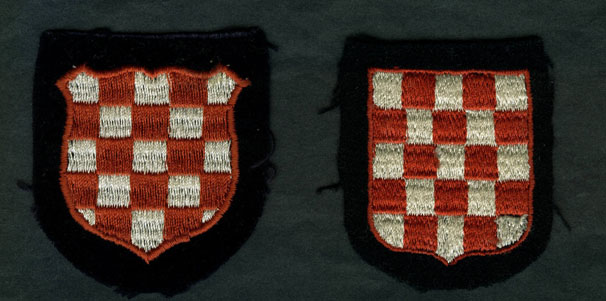
Both Croatian shields were issued and worn by volunteers in the "13th SS Mountain Division Handschar." |